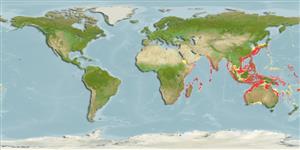分類 / Names
共通名の | 類義語 | Catalog of Fishes(部類, 種) | ITIS | CoL | WoRMS | Cloffa
Environment: milieu / climate zone / depth range / distribution range
生態学
海; 汽水性の 関連する礁; 深さの範囲 45 - 375 m (Ref. 33390). Tropical; 39°N - 35°S, 23°E - 179°W (Ref. 5222)
Indo-West Pacific: east coast of Africa to Japan, Korea, South China Sea, Viet Nam, and Fiji. Unknown from the Red Sea and Persian Gulf.
Length at first maturity / サイズ / 重さ / 年齢
Maturity: Lm ?, range 41 - ? cm
Max length : 65.0 cm TL オス/雌雄の選別がない; (Ref. 4319); 最大公表体重: 4.0 kg (Ref. 5222)
背面の脊椎 (合計) : 11; 背鰭 (合計) : 14 - 15; 肛門の骨: 3; 臀鰭: 8. Distinguished by the following characteristics: juveniles are pale yellowish grey in color, with oval black blotch on body between bases of the 3rd to 9th dorsal fin spines and extending to the edge of the fin between 1st and 7th spines; semicircular pale band passes ventrally around the oval black blotch and isolates it from the dark brown band that begins broadly on nape and bifurcates just behind operculum, upper branch curving dorsally and expanding broadly over the basal half of the dorsal fin between 9th spine and 4th soft ray, lower branch also curving dorsally and expanding at the base of the last 4 dorsal-fin rays; presence of 2nd curved band, parallel to the one above, runs from interorbital area and rear edge of the eye to a black saddle spot on caudal peduncle; 3rd narrow dark brown band, from lower edge of eye to the subopercle and continues as a series of dark dots along ventral part of the body to the base of caudal fin; pale yellow fins, except where dark markings occur on dorsal fin; adults with faint or absent dark spots on body; fins are yellowish brown, triangular interspinous dorsal fin margins abruptly orange-yellow or brownish yellow; soft dorsal, anal and caudal fins shading to blackish distally with bluish white edge; body depth contained 2.6-3.1 times in SL; head length 2.3-2.5 times in SL; interorbital area slightly convex; 2-5 enlarged serrae at preopercle angle; slightly convex upper edge of operculum; maxilla reaches about to vertical at rear edge of eye; maxilla in adults with step on edge; posterior nostrils of adults larger than anterior ones; 2 rows of teeth on midlateral part of lower jaw; pyloric caeca 8-9 (Ref. 89707).
Reef-associated (Ref. 89707). Inhabits relatively deep water (Ref. 5222). Feeds on fishes and crustaceans (Ref. 89707).
Life cycle and mating behavior
成熟 | 繁殖 | 放精 | 卵 | 生産力 | 幼生
Heemstra, P.C. and J.E. Randall, 1993. FAO Species Catalogue. Vol. 16. Groupers of the world (family Serranidae, subfamily Epinephelinae). An annotated and illustrated catalogue of the grouper, rockcod, hind, coral grouper and lyretail species known to date. Rome: FAO. FAO Fish. Synop. 125(16):382 p. (Ref. 5222)
IUCNのレッドリストの状況は (Ref. 130435: Version 2024-1)
Human uses
水産業: 食糧水産
用具
特記事項
XMLをダウンロードして下さい
インターネットの情報源
Estimates based on models
Preferred temperature (Ref.
123201): 15.1 - 26.6, mean 20.7 °C (based on 556 cells).
Phylogenetic diversity index (Ref.
82804): PD
50 = 0.5000 [Uniqueness, from 0.5 = low to 2.0 = high].
Bayesian length-weight: a=0.01175 (0.00568 - 0.02430), b=3.04 (2.88 - 3.20), in cm total length, based on LWR estimates for this Genus-body shape (Ref.
93245).
栄養段階 (Ref.
69278): 4.0 ±0.66 se; based on food items.
回復力 (Ref.
120179): 低い, 4.5年~14年の倍増期間の最小個体群 (Preliminary K or Fecundity.).
Fishing Vulnerability (Ref.
59153): Moderate to high vulnerability (46 of 100).
